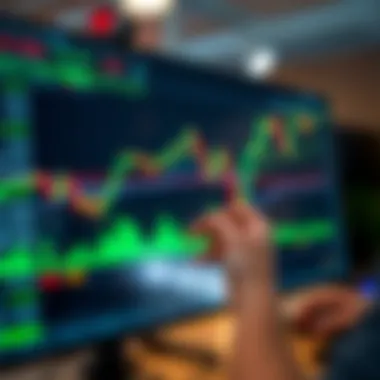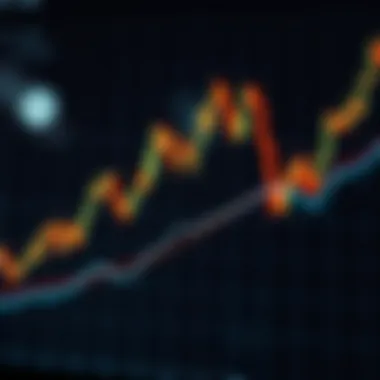Mastering Technical Analysis with TradingView


Intro
When navigating the intricate waters of cryptocurrency trading, having a reliable map can be the difference between sinking and swimming. Technical analysis serves as that map, providing traders with tools to interpret market movements, understand price actions, and make informed decisions. Among the plethora of platforms available, TradingView stands out with its user-friendly interface and sophisticated features. In this guide, we’ll delve into the essence of technical analysis as it pertains to TradingView, uncover key concepts, and discuss practical applications to enhance your trading strategies.
Crypto Concepts Explained
Technical analysis isn't just about charts and indicators; it's rooted in understanding the underlying concepts that drive market behavior. Let’s explore some foundational terminology and their significance in the context of TradingView and cryptocurrency trading.
Key Terminology and Definitions
- Bull Market: A phase where prices rise, often driven by investor confidence and favorable news. In a bull market, traders typically feel optimistic.
- Bear Market: Conversely, a bear market is characterized by falling prices and pessimism among investors. Recognizing these trends is vital when utilizing TradingView for trading decisions.
- Candlestick Chart: A graphical representation of price movements, where each candlestick shows the opening, closing, high, and low prices within a specific time period. This is one of the primary tools available in TradingView and essential for visualizing market dynamics.
- Support and Resistance Levels: Support refers to price levels where a downtrend can be expected to pause due to a concentration of demand. Resistance is the opposite, where an uptrend stalls due to an abundance of supply. Understanding these concepts can empower traders to make strategic decisions.
These terms form the backbone of technical analysis. Familiarity with them ensures that users can effectively communicate trading ideas and strategies within the TradingView platform.
Practical Applications of Blockchain Technology
While TradingView's focus is primarily on price analysis, understanding the broader context of blockchain technology enhances a trader's perspective. Here are various applications that impact market movements:
- Smart Contracts: Programs stored on a blockchain that run when predetermined conditions are met. They can cause shifts in asset prices based on execution events, so keeping an eye on projects that leverage smart contracts can be advantageous.
- Decentralized Finance (DeFi): Platforms using blockchain to recreate traditional financial systems without intermediaries. Their growth can substantially influence cryptocurrency markets.
- Tokenomics: The economic model for a cryptocurrency. A sound tokenomics strategy can increase demand, thus influencing price, which is critical to consider when charting out your trades on TradingView.
By grasping both the concepts of technical analysis and the broader implications of blockchain technology, traders can elevate their strategies beyond mere speculation.
Investment Strategies
Understanding and implementing investment strategies is indispensable for anyone looking to navigate the volatile world of cryptocurrencies.
Analyzing Market Trends and Indicators
When using TradingView, recognizing market trends and employing technical indicators is key. Here are a few popular indicators:
- Moving Averages: These are used to smooth price data and identify the direction of the trend. For example, the 50-day moving average can provide insights into medium-term price movements.
- Relative Strength Index (RSI): This momentum oscillator measures the speed and change of price movements, helping traders identify overbought or oversold conditions.
- Bollinger Bands: These bands provide a relative definition of high and low prices. They consist of a middle band (SMA) and two outer bands that expand or contract based on market volatility.
Risk Management Techniques
Risk management cannot be understated. Below are techniques traders should adopt:
- Setting Stop-Loss Orders: This technique allows traders to specify a price at which a position will be automatically closed, thus limiting potential losses.
- Diversifying Investments: Avoid putting all your eggs in one basket can reduce overall risk. Consider having a mix of cryptocurrencies that show different market behaviors.
- Position Sizing: This practice involves determining the appropriate amount of capital to allocate to a trade based on individual risk tolerance and market conditions.
Incorporating these strategies within TradingView can facilitate a more structured approach to trading, ultimately leading to more informed decisions.
"The market is driven by people, and people are driven by emotions." Understanding this human element intertwines technical analysis and successful trading practices.
By blending the tools and techniques available on TradingView with a solid foundation of technical analysis, investors and traders can make calculated decisions in the ever-evolving landscape of cryptocurrency.
Preamble to Technical Analysis
To grasp the intricacies of trading, understanding technical analysis is paramount. This method acts as a compass in the tumultuous seas of financial markets, guiding traders toward informed decisions based on price movements and market data. It's not merely about numbers; it’s a blend of art and science that hinges on specific patterns and indicators derived from historical price action.
Technical analysis empowers investors, analysts, developers, enthusiasts, and educators alike by providing tools to interpret past market behavior. Through these interpretations, people can formulate strategies that anticipate future price changes. This approach transcends various markets, from stocks to cryptocurrencies, offering a universal language in trading.
Benefits of Technical Analysis
- Data-Driven Decisions: Rather than relying solely on gut feelings, technical analysis relies on objective data, fostering a culture of analytical thinking.
- Enhanced Market Timing: Traders can identify trends and reversal points, optimizing entry and exit strategies.
- Framework for Diversification: Understanding how markets work can enhance risk management through better asset allocation strategies.
Still, there's more to consider than just numbers on a chart. Technical analysis requires a knack for spotting trends—whether they’re fleeting or sustained—and discerning between noise and valuable signals. All traders must remain aware that while historical price movements can suggest potential future behavior, they do not offer guarantees. Therefore, a well-rounded approach to investing often fuses technical with fundamental analysis for a comprehensive view.
Understanding Technical Analysis
At its core, technical analysis is the study of past market data to forecast future price movements. This approach operates under the premise that all relevant information is already reflected in a security's price, allowing traders to utilize charts and indicators to guide their decisions.
The following elements are essential in technical analysis:
- Charts: The primary tool for visualizing price movements over time. Various types, such as line charts, bar charts, and candlestick charts, offer different perspectives.
- Indicators: Tools that help in measuring momentum, volatility, and market strength. Popular ones include moving averages, Relative Strength Index (RSI), and Bollinger Bands.
- Patterns: Recognizing chart patterns, whether they be bullish or bearish, can signal potential price movements.
Traders should also consider market psychology. The idea is that crowd behavior plays a significant role, as traders collectively react to price movements, creating trends that can be analyzed.
Key Points to Remember:
- Unlike fundamental analysis, which looks at economic factors and company health, technical analysis is solely focused on price action and market activity.
- Past performance doesn’t guarantee future results, but understanding historical trends provides insight into potential reactions under similar conditions.
Historical Context and Evolution
The roots of technical analysis can be traced back centuries, with various forms of charting and market analysis evolving over time. Understanding its historical context unveils how this methodology has morphed into what traders use today.
In the late 19th century, Charles Dow, one of the founders of Dow Jones & Company, introduced concepts that laid the groundwork for modern technical analysis. His creation of the Dow Theory emphasized the importance of price trends and market cycles, forming the backbone of market movement analysis that persists today.
As decades rolled on, the introduction of charting software in the late 20th century transformed how traders conducted technical analysis. The internet brought a torrent of information, democratizing trading knowledge like never before.
Technical analysis has evolved from rudimentary hand-drawn charts to dynamic software platforms like TradingView, offering real-time data and sophisticated tools that empower today's traders.
With advancements in technology, the practice of technical analysis continues to grow, integrating machine learning and artificial intelligence to enhance predictive capabilities. This ongoing evolution signifies that while the fundamental essence of analyzing price trends may remain, the tools and techniques at traders' disposal will keep on getting more refined, strengthening the role of technical analysis in modern trading.
Overall, the significance of technical analysis in trading, particularly with tools like TradingView, cannot be overstated. It's a crucial element for anyone serious about understanding market movements and translating that knowledge into tangible trading strategies.
The Role of TradingView
When discussing technical analysis, the role of TradingView cannot be overstated. This platform has emerged as a premier tool for traders and investors, providing a comprehensive suite of resources designed to enhance decision-making. The simplicity of setting up your account paired with its powerful functionalities caters not just to seasoned traders but also to those just embarking on their trading journey. This section delves into why TradingView stands out in the crowded field of trading platforms and how its features can significantly impact trading outcomes.
Preamble to TradingView
TradingView is a web-based platform that allows users to access live charts, research information, and share trading ideas in real-time. It has garnered a reputation for its user-friendly interface, which permits even the greenest of traders to engage in technical analysis without feeling overwhelmed. With thousands of indicators, customizable charts, and social networking elements, TradingView becomes more than just a charting application—it's a community of traders all sharing the common goal of improving market understanding.


One great aspect of TradingView is its free access model. Most of the features, including basic charts and some indicators, are accessible without cost. However, for those who desire the full experience, there are various tiers of paid subscriptions that unlock advanced indicators, multiple charts on one screen, and more in-depth analysis tools.
Accessibility is key. Given that it's web-based, users can access their charts from any device—be it a computer, tablet, or phone—making it incredibly flexible for traders on the go. This portability is essential in the fast-paced market world, enabling users to react swiftly when conditions change.
Key Features of TradingView
The platform encompasses a wealth of features that make technical analysis not just feasible, but also highly effective. Here are some highlights:
- Advanced Charting Tools: Users can create dynamic charts that allow for various time frames and styles, helping to tailor the visual representation of data to individual preferences.
- Over 100 Built-in Indicators: From moving averages to oscillators, users have a range of tools at their fingertips to analyze price movements and trends effectively.
- Social Network Integration: A unique aspect is TradingView's focus on social interaction. Users can share their charts and analyses with others, providing feedback and fostering a sense of community amongst traders. This could potentially allow one to learn strategies that worked for someone else, bridging the gap in knowledge.
- Screener Tools: The screener tools that TradingView provides allow users to filter stocks based on specific criteria. This functionality is particularly useful for identifying potential trading opportunities based on technical setups.
- Custom Scripts and Studies: Users can create their own custom indicators and strategies by utilizing TradingView’s Pine Script language, enabling an even more personalized trading experience.
- Multi-time Frame Analysis: Switching between different time frames is seamless, allowing traders to analyze trends from short-term spikes to long-term movements without losing context.
- Widgets for Websites: Traders can embed charts on their websites, making it easy to share their analyses or to provide a richer experience on their blogs or services.
In summary, the multifaceted features of TradingView are integral to building a strong foundation in technical analysis. Its combination of interactive charts, broad community engagement, and extensive analytical tools creates a supportive environment for both novice and advanced traders.
Setting Up Your TradingView Account
Setting up your TradingView account is a fundamental step in your journey towards effective technical analysis. Having a robust platform like TradingView at your fingertips enhances your ability to analyze, strategize, and execute trades based on data-driven insights. Let's delve into the specifics of creating an account and navigating the interface, the essentials that make your analysis smoother and more efficient.
Creating an Account
Creating an account on TradingView is a straightforward process, but it lays the groundwork for a personalized trading experience. Here’s how it works:
- Visit the TradingView Website: Open your web browser and go to TradingView. You’ll see the option to ‘Join for free’ or ‘Sign Up.’
- Choose Your Sign-Up Method: You can sign up using your email address, or alternatively, you can link your account to platforms like Google or Facebook. This flexibility makes it easier to step into the world of trading without any significant hurdles.
- Fill in Your Details: If you opt for email registration, you’ll need to provide some basic information such as your name, email, and a secure password. Make sure to use an email address you regularly check, as you might need to verify it.
- Agree to Terms and Conditions: It’s crucial to read through TradingView’s terms and conditions. While it might seem tedious, understanding the rules can save you from potential issues down the line.
- Verification: After submitting your details, you may receive a verification email. Follow the link to confirm your account. Once verified, you can log in and start exploring.
Creating your TradingView account not only opens doors to advanced charting tools but also grants access to a community of traders. It’s a gateway that connects you with insights and strategies shared by others navigating the same markets.
Navigating the Interface
Once you've successfully created your TradingView account, you’ll find yourself greeted with an intuitive interface designed to make analysis a breeze. Familiarizing yourself with this layout is essential for tailoring your trading experience. Let’s break it down:
- The Chart Area: This is where the magic happens. You’ll find customizable charts that display various financial instruments in real-time. You can zoom in, scroll, and even split your screen to view multiple charts at once.
- Toolbox Panel: On the left side, you’ll notice the toolbox panel. Here lies an array of tools such as trendlines, shapes, and various drawing instruments that help you annotate your charts and make sense of price movement visually.
- Indicators and Strategies: At the top of the chart area, explore the options for adding indicators and strategies. TradingView supports a multitude of technical indicators, from simple moving averages to complex oscillators, allowing you to tailor your analysis uniquely.
- Watchlist: Keep an eye on your preferred assets with the watchlist feature, usually located on the right side of the screen. This makes it convenient to track price movements without rummaging through different assets. You can add or remove assets as you please.
- Social Features: Don’t underestimate the community aspect. At the bottom, you’ll find sections for social interaction where you can share ideas or discover analyses shared by other traders. Engaging with them can provide fresh perspectives and improve your understanding of market trends.
Navigating the TradingView interface effectively can enhance your trading efficiency. Remember, spending some time to explore features and settings can significantly impact your trading strategy. The more comfortable you get with the tools available, the better positioned you will be to capitalize on market opportunities.
Interpreting Charts
Interpreting charts is a vital skill for traders and investors alike, as it provides the visual representation of market data essential for making informed decisions. A well-interpreted chart acts like a compass, guiding you through the complex terrain of financial markets. By analyzing price movements and identifying trends, you can better understand market sentiment and anticipate potential changes in direction. This understanding allows you not only to navigate the markets more effectively but also to refine your overall trading strategy.
When it comes to interpreting charts, there are several specific elements that one should pay attention to. The most fundamental elements include, but are not limited to, price trends, support and resistance levels, and chart patterns. Recognizing these elements can significantly enhance one’s ability to predict future price movements.
Analyzing Price Action
Price action is essentially the foundation of technical analysis. It refers to the actual movement of a security's price over time. By looking at price action, traders can glean insight into the underlying strength or weakness of a security. For instance, if a stock is making higher highs and higher lows, it indicates a bullish trend—suggesting confidence among buyers. Conversely, if the price is making lower lows and lower highs, it shows a bearish trend, with sellers in control.
- Bullish Price Action: An indication that buyers are dominating the market. Look for patterns like breakout candles or bullish engulfing.
- Bearish Price Action: This can suggest sellers are leading the charge; patterns such as shooting stars or bearish engulfing often serve as red flags for traders.
Using TradingView, you can easily visualize these movements by setting up candlestick or line charts. Each candlestick does not just tell you the opening and closing price but also the high and low within a certain timeframe, providing a wealth of information at a glance. Keeping an eye on how candles behave around support and resistance can be particularly illuminating.
Understanding Volume Indicators
Volume indicators play a crucial role in confirming price movements. Simply put, volume indicates the number of shares or contracts traded in a specific timeframe, reflecting the strength behind a price move. High volume typically bolsters confidence in a trend since it suggests that many traders support that movement, whereas low volume can indicate a lack of conviction.
- Volume Patterns: Observe signs like increasing volume on a price breakout or a price pullback. If a stock is moving up with rising volume, this often signals a strong bullish sentiment.
- Divergence: Sometimes, you'll spot scenarios where price moves up but volume decreases. This kind of divergence can hint at a potential reversal, suggesting that traders might be losing interest in the move.
Using TradingView, one can seamlessly integrate volume indicators like the Volume Oscillator or On-Balance Volume to assist in making sense of trades. These indicators can provide layers of insight that pure price action might not offer.
"A wise trader will seek out volume trends in addition to price fluctuations; the two together can provide a more comprehensive understanding of market dynamics."
In summary, interpreting charts, analyzing price action, and understanding volume indicators are crucial skills for traders. By grasping these concepts, you not only improve your trading efficacy but also build a robust foundation upon which to develop intricate strategies. Investing the time to learn and understand these tools and techniques could very well be the difference between success and failure in cryptocurrency trading.
Incorporating Indicators
The art of trading on financial markets often relies as much on data analysis as it does on human intuition. When it comes to technical analysis, incorporating indicators is like adding a compass to your navigation toolkit, steering your decisions based on market psychology and price movement. Indicators function as visual representations that help traders interpret data more clearly, revealing patterns and trends that might remain hidden to the naked eye. By utilizing both standard and custom indicators, investors can develop a more nuanced understanding of price action, which ultimately enhances their strategy and decision-making process.
Commonly Used Indicators
There exists a plethora of indicators at the disposal of traders, each chief among them boasting distinct purposes. Understanding these indicators can significantly reduce misjudgments in trading. Here are a few that are often seen in trading charts:
- Moving Averages: This indicator smooths out price action over a specific period. It helps in identifying trends and determining entry/exit points. The simple moving average (SMA) and exponential moving average (EMA) are common types.
- Relative Strength Index (RSI): Positioned on a scale from 0 to 100, this momentum oscillator indicates whether an asset is overbought or oversold. Typically, a reading above 70 suggests overbought conditions, while below 30 indicates oversold.
- Bollinger Bands: These bands expand and contract based on market volatility. The price trading near the upper band indicates overbought conditions, while trading near the lower band suggests oversold conditions.
To exemplify these concepts, the Moving Average Convergence Divergence (MACD) is another widely employed indicator among traders. It utilizes two moving averages and their intersection to deliver buy or sell signals, thus acting as a momentum indicator.
Understanding these tools and integrating them into your market analysis can be transformative, but awareness of their limitations is equally as important.
Custom Indicators in TradingView
TradingView stands out not just for the breadth of indicators provided but also for the flexibility it offers in crafting your own custom indicators. The Pine Script programming language allows users to tailor indicators according to personal trading strategies. This adaptability provides a dual benefit: it fosters originality in approaches and allows fine-tuning to particular market conditions or personal trading preferences.
For instance, consider a trader who places importance on specific market dynamics not captured by existing indicators. By using Pine Script, they can create an indicator that captures those nuances. Suppose the trader wishes to visualize price changes relative to significant news events. They have the chance to build a custom tool that layers market sentiment data with price action, thereby uncovering insights potentially overlooked by mainstream indicators.
Benefits of customizing indicators include:
- Personalization: Traders can adjust settings tailored to their own risk tolerance, strategy, and market environments.
- Creativity: The ability to think outside the box can lead to the development of new analytical tools that could gain popularity.
- Adaptive Learning: Custom indicators can evolve alongside the trader's understanding and experiences in the markets.
"Indicators are not just tools; they're the lenses through which we view market dynamics. Select them wisely and they can enrich the trading experience."
For further insights into TradingView and its features, visit TradingView or explore educational resources on platforms such as Investopedia and BabyPips.
Developing Trading Strategies
In the world of trading, strategies are not just a good idea; they are essential. A trading strategy is a systematic approach to making trading decisions. It lays down the groundwork that directs you through market fluctuations, minimizing emotional decision-making that can often lead to poor outcomes. This section delves into the importance of developing trading strategies, with a focus on specific areas like trend following and counter-trend strategies.
A well-thought-out trading plan not only outlines your trading methods but also defines the reasoning behind your choices. Without a clear strategy, traders may find themselves lost in a sea of charts and indicators, swayed by market noise or fleeting sentiments. Whether you're a seasoned analyst or a budding investor, having a strategy can make all the difference in your trading success.
Key Elements of a Trading Strategy


- Objective: Clearly state what you aim to achieve—be it profit growth, risk diversification, or portfolio stability.
- Risk Management: Set your risk tolerance and create safeguards like stop-loss orders.
- Entry and Exit Criteria: Define when to enter and exit trades based on your analysis and market indications.
- Performance Evaluation: Regularly assess your strategy's effectiveness and make adjustments when necessary.
A strategy is like a compass in the ever-changing landscape of trading. Without it, you may struggle to find your way.
Benefits of Developing Trading Strategies
Developing structured trading strategies can have multiple advantages:
- Consistency: A defined strategy leads to predictable outcomes, enhancing discipline over impulses.
- Improved Analysis: By following a methodology, you can enhance the quality of your market analysis.
- Risk Mitigation: Understanding your risk parameters helps protect your investments.
Having a well-developed approach allows traders to navigate complexities in the market, adjusting their focus on what truly matters.
Considerations Before Implementing a Strategy
It's crucial to keep certain factors in mind:
- Market Conditions: Different strategies may work better in varying market states.
- Psychological Factors: Fear and greed can cloud judgment; a pre-defined strategy can help in maintaining emotional control.
- Adaptability: Be open to evolving your strategy based on market shifts and new learnings.
Use resources like Investopedia or TradingView to explore further insights into effective trading strategies and their practical applications.
Trend Following Strategies
Trend following is a strategy that revolves around riding the wave of market trends. The core principle here is straightforward: buy when the market is going up and sell when it’s heading down. This becomes crucial because trends tend to sustain themselves over time, whether in an uptrend or downtrend.
Implementation of Trend Following
To successfully employ this strategy, consider using tools like moving averages or the Average Directional Index (ADX) to identify whether the market is trending.
- Identify the Trend: Use indicators to determine the prevailing market direction.
- Entry Points: Look for signals that confirm your analysis, such as price moving above a moving average.
- Exit Points: Set predetermined take-profit levels based on historic resistance areas or trend lines.
Incorporating support and resistance levels can give added insight into where trends might reverse, giving you an edge.
Advantages of Trend Following
- Simplicity: By focusing on market direction, trends are easier to recognize than minute fluctuations.
- Momentum: Riding on the coattails of established trends can yield significant returns.
- Risk Management: Logical extraction points help streamline exit strategies which are essential to overall risk control.
While this strategy has its perks, it's important to stay alert for potential reversals as they can lead to quick losses if not identified in time.
Counter-Trend Strategies
Counter-trend strategies, as the name implies, involve trading against prevailing market trends. The premise of this strategy is based on the idea that market trends aren’t eternal; they will eventually reverse.
Practical Steps in Counter-Trend Trading
Implementing counter-trend strategies requires skill and a keen eye for details. Here’s how you can approach this:
- Analyze the Market: Use both technical indicators like the Relative Strength Index (RSI) to detect overbought or oversold conditions.
- Identify Reversal Patterns: Look for candlestick formations that suggest a potential reversal.
- Set Tight Stops: Since this strategy typically has a higher risk, using tight stop-loss orders can safeguard your capital.
Pros and Cons of Counter-Trend Strategies
- Advantages:
- Disadvantages:
- Higher Risk Rewards: Though riskier, successful counter-trend trades can yield substantial profits.
- Market Efficiency: Often leads to uncovering hidden opportunities that trend followers might overlook.
- Greater Risk: This strategy requires a strong discipline due to its speculative nature.
- Requires Patience: Waiting for the right setup can take significant time, which may test emotional tolerance.
Both trend following and counter-trend strategies play pivotal roles in the toolbox of technical analysis. Understanding the dynamics behind each can facilitate better decision-making when navigating the market landscape.
Risk Management in Technical Analysis
In the fast-paced world of trading, risk management is not a mere accessory; it’s the bedrock of a sound trading approach. For both seasoned traders and newcomers, understanding how to effectively manage risk is essential to safeguard capital and enhance long-term profitability. In the context of technical analysis using TradingView, risk management takes center stage, enabling traders to navigate the complexities of market dynamics while maintaining a clear game plan.
The importance of risk management cannot be overstated. It helps in establishing the boundaries within which one decides to operate. By defining your risk tolerance and understanding the potential downsides of any trade, you lay down a roadmap that guides your every move in the market. Without this foundational aspect, traders may find themselves lost in emotional reactions to market fluctuations instead of following a disciplined strategy. In short, sound risk management can protect against significant losses while fostering a more stable trading environment.
Establishing Risk Parameters
Setting clear risk parameters is the first step towards effective risk management. This involves determining how much capital you are willing to risk on each trade, a practice many seasoned traders advocate for. A commonly suggested guideline is to risk no more than 1-2% of your total trading account on any single trade. This ensures that even a series of losing trades won't see your account significantly depleted.
It’s also crucial to consider the type of asset you are trading. Different markets exhibit varying levels of volatility, so your risk parameters might differ based on whether you're trading cryptocurrencies, stocks, or forex. To get a sense of how these parameters work, you can utilize tools available in TradingView that allow you to simulate and visualize potential losses based on selected risk parameters.
Setting Stop-Loss and Take-Profit Levels
Once you have established your risk parameters, setting stop-loss and take-profit levels becomes your next priority. These levels are vital as they help to solidify your trading plan and can minimize emotional decision-making. A stop-loss order is designed to sell a security when it reaches a certain price, thereby limiting losses. On the contrary, a take-profit order locks in profits by selling when the price reaches a predetermined level.
Some popular strategies for setting these levels involve:
- Technical Analysis Tools: Utilize support and resistance levels to determine where to place your stop-loss and take-profit orders.
- Risk-to-Reward Ratio: Aim for a risk-to-reward ratio of at least 1:2, meaning for every unit of risk, your potential reward should be double.
- Market Conditions: Adapt your orders according to current market conditions, assessing volatility levels that might require adjustment.
"The secret to profitable trading is to have a plan and stick to it, no matter the market noise."
By consistently applying these principles of risk management, traders can significantly improve their chances of achieving long-term success in the markets. Understanding when to exit a trade, whether it be in profit or loss, is just as important as entering the trade itself. In a nutshell, risk management in technical analysis isn't a constraint, but rather a strategic advantage that can lead to informed decision-making and sustainable trading habits.
Chart Patterns and Their Implications
Understanding chart patterns holds immense significance in technical analysis, particularly when leveraging TradingView. These patterns serve as visual indicators of market behavior, providing insights into potential future price movements. By recognizing these formations, traders can forecast market trends and adjust their strategies accordingly. It’s not a crystal ball, but it’s close enough with diligent application.
Chart patterns not only aid in analyzing price data, but they can also unveil the sentiment behind movements. Patterns can reflect whether bulls or bears are dominating a given market, which is crucial for making educated trading decisions. Moreover, knowing these patterns arms traders with the ability to time their entries and exits more effectively.
Common Chart Patterns
In the realm of chart analysis, familiarity with common chart patterns is endoging for successful traders. Some of the most utilized patterns include:


- Head and Shoulders: Often considered a reliable trend reversal pattern, it consists of three peaks—two lower peaks on either side of a higher peak (the head). Traders watch for the breakout through the neckline to confirm a reversal.
- Double Tops and Bottoms: Indicative of potential reversals, the double top is formed after an upward trend, while the double bottom appears following a downward trend. A breakout beyond the prevailing price range gives traders a clearer signal to act.
- Triangles (Ascending, Descending, and Symmetrical): These patterns typically indicate a period of consolidation. A breakout from the triangle can signal a continuation or reversal, contingent on the preceding trend.
- Flags and Pennants: Both patterns suggest brief pauses in price movements before the previous trend resumes. Flags are rectangular-shaped, whereas pennants are symmetrical triangles.
Understanding these patterns is the key to decoding market intentions. When they appear on your TradingView charts, be on alert for trading opportunities that might follow.
Recognizing Continuation vs. Reversal Patterns
Recognizing the difference between continuation and reversal patterns is paramount. Continuation patterns indicate that the current trend will likely persist, while reversal patterns signal an impending change in market direction.
- Continuation Patterns include flags and pennants, where the price simply takes a breather before continuing in the same direction. Traders often view these as signs that the trend isn’t finished yet.
- Reversal Patterns, such as head and shoulders or double tops/bottoms, suggest a shift in momentum. When you spot these formations, they might signal a well-needed exit from an existing position, especially if you’re riding a trend that may be nearing its end.
Recognizing these differences allows traders to tailor their strategies intelligently, adapting to the changing nature of the market. With chart patterns, it’s all about interpretation and timing—diligently tracking these markers can potentially elevate a trading plan from good to great.
"Patterns are there as guides; it's upon the trader to decipher their language."
For more insights on chart patterns, consider exploring Investopedia’s guide which delves into various formations and their interpretations.
Using Fibonacci Levels
Fibonacci Levels hold significant importance in the realm of technical analysis. Investors and traders alike rely heavily on these levels to predict market behavior and identify potential price movements. To get down to brass tacks, Fibonacci retracements are instrumental in discerning support and resistance levels, providing critical guidance in formulating trading strategies.
The allure of Fibonacci Levels lies in their mathematically derived ratios, which have been proven effective across various asset classes, including stocks, currency pairs, and cryptocurrencies. The basic concept revolves around the Fibonacci sequence, where each number is the sum of the two preceding ones. The ratios derived from these numbers, such as 23.6%, 38.2%, 61.8%, and 76.4%, serve as key levels in price charts where potential reversals or continuations may occur.
Prelims to Fibonacci Analysis
To better understand Fibonacci Levels, let’s explore its origins. The sequence originates from Leonardo of Pisa, commonly known as Fibonacci. He introduced it to the Western world in the 13th century through his book "Liber Abaci." The concept of Fibonacci has since permeated various fields, including finance.
In technical analysis, Fibonacci Levels come into play during a price trend, indicating where a stock, or another financial instrument, is likely to experience pullbacks or breaks of support. Understanding these levels enhances a trader's ability to make informed decisions, as they mark areas where the price may find support before moving in the direction of the trend.
When employing Fibonacci analysis, context is critical. Traders often use it alongside other indicators and chart patterns to crystallize their evaluations. Notably, it’s essential to draw Fibonacci retracements from a significant peak to a trough (or vice versa) to effectively measure and predict potential price action.
Application of Fibonacci Retracement
Applying Fibonacci retracement levels in practice requires a solid understanding of your charting tools, particularly in TradingView. Here's how one might typically go about it:
- Identify Swing Highs and Lows: Locate the highest and lowest points in the timeframe you are analyzing. This could be a daily, weekly, or monthly chart depending on your trading strategy.
- Draw the Fibonacci Retracement: With your toolset in TradingView, select the Fibonacci retracement tool. Click on the swing high point and drag it down to the swing low point (or the other way around for an uptrend).
- Observe Key Levels: The horizontal lines will appear across your chart, representing critical Fibonacci levels. Each percentage level has its own implication, with 61.8% being particularly noteworthy for reversals.
- Combine with Other Indicators: A smart trader doesn’t rely solely on Fibonacci levels. Integrating these levels with moving averages, trendlines, or RSI can bolster decision-making.
"Understanding Fibonacci Levels can be the difference between mere speculation and well-thought-out trading strategies."
In short, utilizing Fibonacci retracements might seem straightforward, but making effective use of them demands a deeper understanding of market dynamics and chart analysis. The ability to recognize how various Fibonacci ratios coincide with critical price levels can lead to more accurate trading decisions and potentially greater success in trading endeavors.
Understanding Candlestick Patterns
Candlestick patterns hold a crucial place in technical analysis, serving as visual representation of price movements in financial markets. Their significance lies in the fact that they encapsulate information about market sentiment and trader psychology. The beauty of candlestick patterns is their ability to tell a story with just a few strokes of the pen, or in our case, pixelation on a screen. Understanding these patterns empowers investors, analysts, and traders to make informed decisions based on historical data and anticipated future movements.
Recognizing and interpreting these patterns isn't merely a skill; it's an art form that blends technical knowledge with psychological insight. Professionals who can effectively decipher candlestick formations open up a universe of potential strategies, bridging the gap between instinct and systematic trading.
Basics of Candlestick Analysis
Candlesticks are composed of four key components: the open, close, high, and low prices for any given time frame. Each candlestick represents price behavior within a certain period, portraying the battle between buyers and sellers. Here’s a clearer breakdown of each element:
- Open: The price at which the asset starts trading for that given timeframe.
- Close: The last price of the asset at the end of the timeframe, often considered the most significant data point.
- High: The highest price reached within that timeframe.
- Low: The lowest price in that same period.
Depending on the relationship between the open and close prices, a candlestick can either be bullish (indicating an upward price movement) or bearish (indicating a downward movement). A bullish candlestick will typically have a green (or white) body, closing higher than it opened, while a bearish candlestick will be red (or black), closing lower than it opened.
Here’s a handy table to summarize the basics:
| Candlestick Type | Color | Meaning |
| Bullish | Green | Price closed higher |
| Bearish | Red | Price closed lower |
In this way, traders can glean insights based on the candlesticks they observe, potentially predicting future price movements. Getting comfortable with reading candlesticks is essential when utilizing TradingView since the platform offers numerous features and tools that enhance this form of analysis. Knowing the basics is just the beginning, though; mastering candlesticks requires practice and awareness of market context.
Interpreting Reversal and Continuation Candles
When it comes to candlesticks, distinguishing between reversal and continuation patterns can be a game changer. Reversal candles indicate a potential shift in market direction, while continuation candles signal the trend maintained.
- Reversal Candles: These are indicative of a possible change in trend direction. Classic examples include the Hammer, which indicates a potential bullish reversal following a downtrend.
- Continuation Candles: These mostly suggest that the current trend will continue. Patterns such as the Bullish Engulfing candle, which appears during an uptrend, typically suggests that the trend will persist.
Reading these candles within the context of their surrounding price action provides additional insights. Traders often employ them alongside other technical indicators for more robust decision-making.
"Understanding candlestick patterns is paramount for success in the world of trading; they are the lilies that bloom in the swamp of market noise."
This perspective will elevate your trading strategies when combined with tools on TradingView, which allows for detailed analysis and customization. As each candlestick emerges on your chart, it's worth considering the bigger picture that these formations may reveal. With practice and an analytic mindset, the patterns themselves may become less of a puzzle and more of a reliable roadmap toward informed decisions in trading.
Backtesting Strategies
Backtesting is a crucial practice in trading that involves testing a trading strategy on historical data to assess its viability before applying it to real-market scenarios. It serves as a litmus test to gauge whether a particular strategy has potential merit. For traders, especially those who want to mitigate risks while maximizing returns, backtesting strategies give insights into how well strategies may perform based on past market behavior.
Importance of Backtesting in Trading
The importance of backtesting in trading cannot be overstated. It provides several key benefits:
- Validation of Concepts: By backtesting, traders can validate whether their trading ideas hold water. It’s one thing to have a hypothesis about a trading strategy, but an entirely different kettle of fish to see it work effectively on historical data.
- Risk Assessment: Testing a strategy allows traders to identify the potential risks involved. This includes understanding the drawdowns and the worst-case scenarios encountered during defined periods.
- Refining Strategies: Through backtesting, one can tweak and fine-tune a trading strategy. It gives insight into which aspects may need refinement, helping to create a more robust system.
"Backtesting is a safeguard against the emotional chaos of live trading. A well-tested strategy provides the confidence to follow through, even when markets get rocky."
- Performance Metrics: Traders can derive essential performance metrics such as win-loss ratios, return on investment (ROI), and profit factors. This data serves as a benchmark for real-world performance.
However, one must approach backtesting with caution. Relying solely on historical data can lead to overfitting — where a strategy is tailored too tightly to past performances and fails in future conditions. It’s fundamental to understand that past performance is not necessarily indicative of future results.
Using TradingView for Backtesting
TradingView offers a robust platform for backtesting strategies, making it accessible for both beginners and seasoned traders alike. Here's how you can harness its features effectively:
- Access to Historical Data: TradingView provides a vast array of historical price data. This data can be employed to conduct backtests across various assets, valuable for those trading stocks, forex, or cryptocurrencies.
- Pine Script: TradingView's own programming language, Pine Script, allows traders to create custom indicators and strategies. By scripting a trading strategy, users can implement specific testing parameters that align with their trading plans.
pinescript //@version=5 strategy("My Strategy", overlay=true)
longCondition = crossover(sma(close, 14), sma(close, 28)) if (longCondition) strategy.entry("Long", strategy.long)
shortCondition = crossunder(sma(close, 14), sma(close, 28)) if (shortCondition) strategy.entry("Short", strategy.short)















